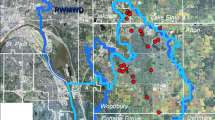Abstract
This study describes the results of wetland construction projects designed to offset wetland losses authorized under the wetland regulatory program of the Commonwealth of Massachusetts, including analysis of 391 project files identified in the study period between 1983 and 1994 and 114 field sites. Detailed comparisons of replacement plant communities were made with remnant impacted wetlands when these existed. Most projects in the study were relatively small, impacting less than 46.5 m2 (500 ft2) of wetland. The majority of projects (54.4%) were not in compliance with the Massachusetts wetland regulations for a variety of reasons, including no attempt to build the project (21.9%), insufficient size or hydrology (29.8%), or insufficient cover of wetland plants (2.6%). Many of the projects constructed (64.9%) were smaller than required. The majority of constructed projects involved impacts to forested wetlands (71.1%). Most replication projects were designed to produce scrub/shrub systems (61.4%), but projects actually built produced no wetland (38.6%), wet meadows (36.8%), or some other wetland type (24.5%). The plant communities produced at replication sites differed significantly from the wetlands they were designed to replace in terms of number of species, cover, and species composition. The similarity of the replication site plant communities did not increase between projects that were new and projects up to 12-years old, indicating that impacted plant communities may not be replaced at most sites for many years, if at all. The completeness of the replication plan and the Order of Conditions (permit) affected the likelihood that a project complied with the regulations but not the level of similarity between the replicated and impacted plant communities. Larger projects constructed under variances from the Massachusetts Wetland Protection Act were much more carefully designed and were all in compliance with the regulations. However, their plant communities were not similar to those of the impacted wetlands they replaced. Variance projects generally provided replication of water quality and sediment control functions but not of wildlife habitat. The state’s goal of no net wetland loss cannot be met unless the regulatory program succeeds in compensating for all authorized wetland impacts.
Similar content being viewed by others
Literature Cited
Bartoldus, C. C., E. W. Garbisch, and M. L. Kraus. 1994. Evaluation for planned wetlands. Environmental Concern, Inc., St. Michaels, MD, USA.
Brown, S. C. 1995. Wetland restoration: factors controlling plant community response and avifaunal habitat value. Ph.D. Dissertation. Cornell University, Ithaca, NY, USA.
Brown, S. C. 1997. Remnant seed banks and vegetation as predictors of restored marsh vegetation. Canadian Journal of Botany 76:620–629.
Brown, S. C. and P. L. M. Veneman. 1998. Compensatory wetland mitigation in Massachusetts. Massachusetts Agricultural Experiment Station, University of Massachusetts, Amherst, MA, USA. Research Bulletin Number 746
Clark, F. H. 1990. Wetland replication: An evaluation of Massachusetts’ mitigation policy. M.A. Thesis. Tufts University, Lincoln, MA, USA. Massachusetts Association of Conservation Commissions Report #116.
Drainville, M. R. and D. J. Whelan. 1990. An analysis of wetland replication and its effectiveness as a form of wetland protection. Worcester Polytechnic Institute, Worcester, MA, USA. Project Number JEM RE67.
Eicher, A. L. 1988. Soil-vegetation correlations in wetlands and adjacent uplands of the San-Francisco Bay estuary, California. U.S. Fish and Wildlife Service, Washington, DC, USA. Biological Report 88(21).
Florida Department of Environmental Regulation. 1991. Report on the effectiveness of permitted mitigation. Tallahassee, FL, USA.
Gleason, H. A. and A. Cronquist. 1991. Manual of Vascular Plants of Northeastern United States and Adjacent Canada, second edition. The New York Botanical Garden, Bronx, New York, NY, USA.
Kent, M. and P. Coker. 1992. Vegetation Description and Analysis: a Practical Approach. Belhaven Press, London, England.
Lake Michigan Federation. 1991. The effectiveness of the U.S. Army Corps of Engineers in requiring, monitoring, and enforcing wetland mitigation in the Great Lakes Basin. Chicago, IL, USA.
Ludwig, J. A. and J. F. Reynolds. 1988. Statistical Ecology. John Wiley and Sons, Inc., New York, NY, USA.
Reimold, R. J. and S. A. Cobler. 1986. Wetland Mitigation Effectiveness. Metcalf and Eddy, Inc., Boston, MA, USA.
Reed, P. B., Jr. 1988. National list of plant species that occur in wetlands: Northeast (Region 1). U.S. Fish and Wildlife Service, Washington, DC, USA. Biological Report 88(26.1).
U. S. Army Corps of Engineers. 1989. Evaluation of freshwater wetland replacement projects in Massachusetts. New England Division, Waltham, MA, USA.
Whitlock, A. L., N. M. Jarman, J. A. Medina, and J. S. Larson. 1994. WEThings: Wetlands habitat indicators for nongame species. The Environmental Institute, University of Massachusetts, Amherst, MA, USA. Publication 94-1.
Wilkinson, L. 1992. SYSTAT for Windows. SYSTAT Inc., Evanston, IL, USA.
WEThings—Birds. 1997. University of Massachusetts, Department of Forestry and Wildlife Management. Amherst, MA, USA. Version 1.1.
Author information
Authors and Affiliations
Corresponding author
Rights and permissions
About this article
Cite this article
Brown, S.C., Veneman, P.L.M. Effectiveness of compensatory wetland mitigation in Massachusetts, USA. Wetlands 21, 508–518 (2001). https://doi.org/10.1672/0277-5212(2001)021[0508:EOCWMI]2.0.CO;2
Received:
Revised:
Accepted:
Issue Date:
DOI: https://doi.org/10.1672/0277-5212(2001)021[0508:EOCWMI]2.0.CO;2




